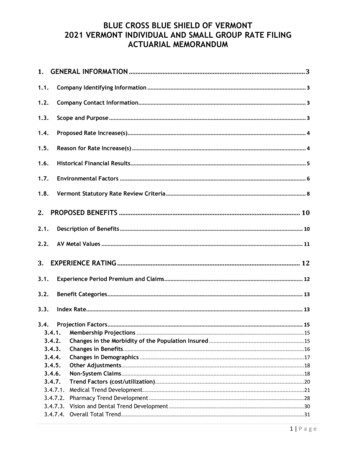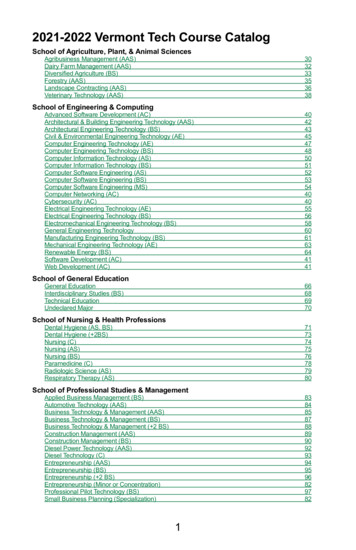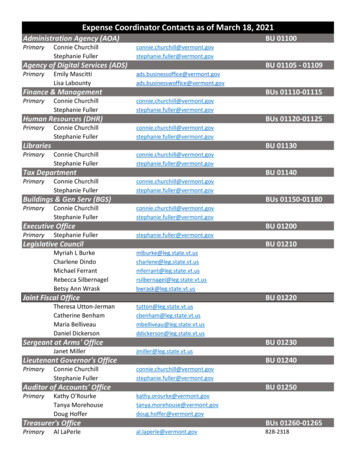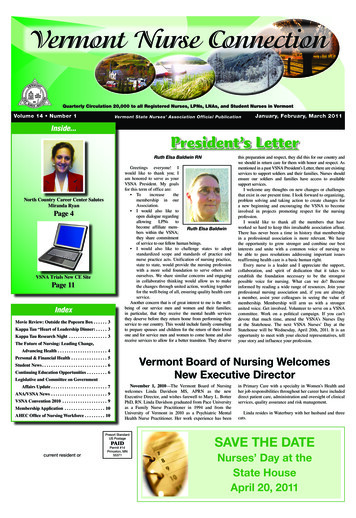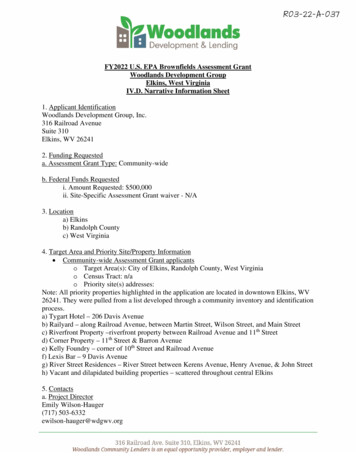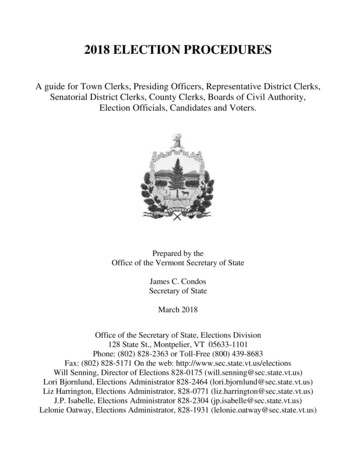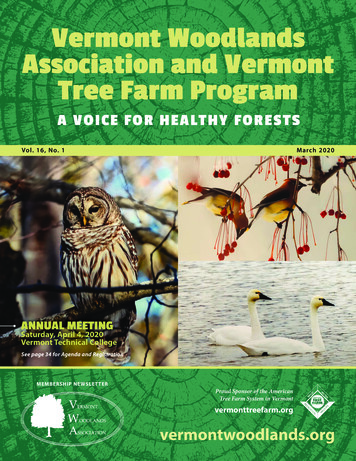
Transcription
Vermont WoodlandsAssociation and VermontTree Farm ProgramA VOICE FOR HEALTHY FORESTSVol. 16, No. 1March 2020ANNUAL MEETINGSaturday, April 4, 2020Vermont Technical CollegeSee page 34 for Agenda and RegistrationMEMBERSHIP NEWSLETTERProud Sponsor of the AmericanTree Farm System in Vermontvermonttreefarm.orgvermontwoodlands.org
VERMONT WOODLANDS ASSOCIATION VERMONT TREE FARM PROGRAMTABLE OF CONTENTSVermont Woodlands Association2020 Officers and DirectorsOFFICERSPutnam W. Blodgett, President, Hanover, NHJohn Buck, Co-Vice President, Waterbury Center, VTAllan Thompson, Co-Vice President, Waterbury, VTTrevor Evans, Treasurer, Newport, VTMarli Rabinowitz, Secretary, Guilford, VTAlan M. Robertson, Secretary, Sheffield, VTDIRECTORSJamey Fidel, Montpelier, VTChris Fife, Fairfield, MESteve Handfield, Poultney, VTLuke Hardt, Hardwick, VTDan Kilborn, Island Pond, VTLeo Laferriere, Waitsfield, VTJohn McClain, Randolph, VTDavid Paganelli, So. Strafford, VTWilliam Sayre, Bristol, VTDavid Wilcox, Berlin, VTStephen Webster, Randolph, VTKeith Thompson, Advisor, VT Forests, Parks & RecThe View from My Desk.Page 3Supporting Wildlife.Page 4Nemesis for Some, Manna for Others.Page 5The Hinesburg Town Forest.Page 8Forest Tent Caterpillar.Page 7Is Burning Wood Good for Birds. Page 10Vermont’s Watershed Forester. Page 12AMPs and you. Page 14What’s the Legislature Looking at This Year?. Page 16Calendar of Events. Page 162019 Annual Report. Page 18Membership Application. Page 27VWA Legacy Planning. Page 28Welcome. Page 29SFI/AIV Task Force. Page 30Lumberjills Gain Skills. Page 33Annual Meeting Agenda. Page 35Front cover photos: Tom ThomsonBack cover photos: Susan C. MorseAN INVITATION TO OUR MEMBERSWe welcome your submissions for the VWA and TreeFarm newsletter. If you have a story to tell or news ofinterest to share with other landowners, please sendalong so we may consider for future editions. We canaccept articles, photos, or news tidbits via email toinfo@vermontwoodlands.org.Mission Statements:Vermont Tree FarmCommittee MembersRichard Bizzozero, Co-Chair, Tree Farmer, BrookfieldKathy Beland, Co-Chair, Forester, Clarendon, VTAllen Yale, Secretary, Tree Farmer, Derby, VTJayson Benoit, Forester, South Royalton, VTRobert Cowles, Landowner, Derby, VTJock Irons, Tree Farmer, Woodford, VTRyan Kilborn, Forester, W. Topsham, VTIan Martin, Forester, Newfane, VTKyle Mason, Bennington County ForesterDavid Paganelli, Orange County ForesterAlan Robertson, Tree Farmer, Sheffield, VTMary Sisock, Burlington, VTDave Stoner, Tree Farmer, Craftsbury CommonProgram AdministratorKathleen Wanner, Rutland, VTVermont Woodlands Association is a 501(c)(3) nonprofit corporationwhose mission is to advocate for the management, sustainability,perpetuation, and enjoyment of forests through the practice ofexcellent forestry that employs highly integrated management practicesthat protect and enhance both the tangible and intangible values offorests - including clean air and water, forest products, wildlife habitat,biodiversity, recreation, scenic beauty, and other resources - for this andfuture generations. VWA objectives are to communicate the benefitsof working forests, recognize exemplary actions of woodland ownersand managers, provide educational opportunities, and represent itsmembership before governmental bodies.The American Tree Farm System, first organized in 1941, is the Nation'soldest certifier of privately owned forestland. Tree Farm membersshare a unique commitment to protecting watersheds and wildlifehabitat, conserving soil, and providing recreation; and at the sametime producing wood products on a sustainable basis. The VermontWoodlands Association strives to educate, train, and support privateforest landowners in sound management practices concerning wildlife,water, wood, and recreation. We do this by managing and enhancing theAmerican Tree Farm System Program in Vermont.2 Membership Newsletter: Vermont Woodlands Association and Vermont Tree Farm
VERMONT WOODLANDS ASSOCIATION VERMONT TREE FARM PROGRAMNEWS FROM VWAThe View from My Desk:It’s Inspirationalby Kathleen Wanner, Executive DirectorAs always, Vermont Woodlands evolves.Your board and director have an earto the ground and an eye on the worldin an effort to fulfill our mission ofproviding education, outreach, advocacy,and networking. Following the guidanceof strategic planning, we sought tostrengthen and grow partnershipswith like-minded organizations. Wechallenged ourselves to think outsidethe box and increase our visibilityaround the state. We took a bold stepin underwriting on VT Public Radio.We continued many efforts that wereunderway or joined in new ones (see theAnnual Report insert in this newsletter).Our objective is always the same – todeliver on our promise to help you leavethe land better than you found it bybeing conscientious and dedicated landstewards.Throughout the year, I personally hadseveral “aha” moments about my workfor VT Woodlands, VT Tree Farm, andother organizations, moments that havechanged the way I see the world andmy work. Perhaps the most poignantinput came from a Ted Talk calledGolden Circles that turns traditionalthinking upside down. It follows an ideathat was first introduced to me abouta decade ago from a strategic marketerthat people make decisions based onemotion, not fact. And this notion getsto the heart of Golden Circles. Whydo we do what we do? Why are wemembers of organizations? Why do wemake certain purchases and not others?It’s based on shared values and beliefs,on that feeling of “rightness.”This idea that when something feelsright, it probably is, changed the way Iview my responsibilities in 2020. I’d likethis year to be one of forward thinking,based on everything I’ve learned in thepast – perhaps hindsight is 2020 or atleast 2020 is the perfect year to put thatlearning into action.VT Woodlands, as with manyorganizations that rely on membership,sets growth as a number one goal. I amnow a naysayer to that idea. Growthis not our goal. Growth is an outcomeof being mission-focused, of puttingour values and beliefs at the forefront,of being driven by our “why.” And thiswill guide what we do and how we doit. Our Walk in the Woods will see newenergy in 2020, with a reinvigoratededucation committee that is planninga return to monthly, or more, events.And, Woodland Retreat Weekend isscheduled for a comeback! We’ve alreadybegun to ramp up our communicationswith regular enews, facebook posts,and press releases. We are meeting thepublic wherever possible and looking forcultural change in the way people viewforest management.So, I ask you think about “why” youare a member of VWA and to sharethat story with us. Part of ramping upour communication involves hearingfrom you. Send an email to info@vermontwoodlands.org.And, if you want to listen to the TedTalk, it’s on YouTube (18 minutes or thecondensed 5-minute version) and you’llfind it with a simple search for GoldenCircle Ted Talk.vermontwoodlands.org vermonttreefarm.org 3
VERMONT WOODLANDS ASSOCIATION VERMONT TREE FARM PROGRAMPRESIDENT’S COLUMNSupporting Wildlifeby Put Blodgett, PresidentOur woodlands provide food, waterand shelter for a fascinating and diversecollection of wildlife—from tiny insectsto birds, moose and bears. Dr. PeterUpton, a native Vermonter and formerVWA director, was captivated by thisvariety and left 10,000 to VWA forits wildlife programs and membereducation.Another wildlife lover and an admirerof Peter, offered a 25,000 challengeif VWA could raise an equal amountand turn the total into a wildlifeendowment in Peter’s memory. In 2014the challenge was more than met withover 27,000 contributed. The VWAboard combined the challenge and thedonations with Peter’s 10,000, creatinga 62,000 Peter Upton MemorialWildlife Endowment.Since that time additional donationsand stock market appreciation havegrown the endowment to 117,877 as ofDecember 31, 2019.Because wildlife is so important towoodland owners, VWA is enhancingits wildlife programming and offerings.The theme of VWA’s annual meeting atRandolph’s Vermont Technical Collegeon April 4 will be wildlife. The programis designed by recently-retired Fishand Wildlife Department biologist andcurrent VWA director, John Buck.There will be more Walks in the Woodsto see what others have done.Paul Harwood, former VWA directorand vice-president, UVM forestrylecturer, Orange County Foresterand currently a long-time consultingforester, is organizing and hosting theWoodland Retreat Weekend. Wildlifewill be a part of the weekend.4 Membership Newsletter: Vermont Woodlands Association and Vermont Tree FarmPut BlodgettTo support this increased emphasis onwildlife, earnings will be taken fromthe Peter Upton Wildlife Endowment,but the endowment itself cannot betouched.The ultimate goal is to build theendowment to a size that will earn 10,000 EVERY YEAR for VWAwildlife programs, wildlife educationand Walks in the Woods.To continue building this endowment,The Jack and Dorothy ByrneFoundation has offered a 20,000challenge if matched by donations fromVWA members.Would you help match this challengeby making a donation to supportVermont’s wildlife?Please use the VWA addressed envelopeincluded in the newsletter and writeUpton Wildlife Endowment on thememo line of the check. If you prefer,you may also donate online (select JoinUs and Charitable Donations from thedrop down menu) via PayPal or callthe office to give us your credit cardinformation by phone.If Bernie can raise millions in hispresidential race, then Vermontersshould be able to raise thousands tosupport wildlife.
VERMONT WOODLANDS ASSOCIATION VERMONT TREE FARM PROGRAMNemesis for Some, Manna forOthers: American Red Squirrelby John Buck, wildlife biologistWhile conducting my daily vacuumcheck last week I noticed a very lowreading from line #3. A low vacuumreading can be caused by a number ofailments such as a blow-down on theline or frozen sap in the line. However,the weather had been calm and lackingany significant freeze so these twopossibilities weren’t prime suspects. Athird common possibility is damageto the lines by various wildlife species.Moose are known to walk throughlines tearing them down as theytrudge on. Coyotes and bears havebeen observed to bite the lines whichproduces tell-tale puncture holes inthe tubing. But for many sugarmakersthe number one wildlife culprit is theAmerican red squirrel.The squirrels don’t walk through orbite the lines but, as rodents are proneto do, gnaw on them (and on thetaps and fittings too). Damaged anddestroyed taps, fittings, and pipelineis of course more than a nuisance. It’slost productivity in both time and sapcollection. But in thinking about thisin a greater context, red squirrels didn’tfind their place on the earth just to be amenace to sugarmakers.In addition to their inherent intrinsicvalue as a member of the native wildlifecommunity, they are a vital foodsource for a host of forest carnivores.Some of the common beneficiaries ofa red squirrel diet are Cooper’s andsharp-shinned Hawks, barred andgreat-horned owls, grey foxes, bobcats,and fishers to name a few. The species’ability to feed so many other forestresidents is due in large part to theiromnivorous diet and ability to seekshelter in a variety of forest types andconditions. The seeds of coniferoustrees and a host of mushroom speciesmake up a large part of the squirrel’sdiet. Squirrels hoard food in closeproximity to their nest. As they forageabout the forest squirrels performan important ecological functionby distributing seeds and sporesthroughout the forest. This resultsin greater reproductive success forthe trees and fungi and also helps tofortify the forest’s diversity therebystrengthening it against disease andinsect damage.Red squirrel reproduction is anothermeans that keeps the species in goodsupply. They often have two litters peryear, one in the spring and one in latesummer, each with 3-5 litter mates.Gestation is a brief 35 days. Followingbirth the offspring will nurse for about 2months then forage on their own. Theywill reach full body size after another 50days. The following year the now oneyear old squirrels will be sexually matureand capable of producing a litter of theirown. Mortality is very high during thesquirrel’s first year of life where about25% survive to their first birthday. If thatbenchmark is reached squirrels have alife expectancy of 3-5 years.Adding to its survivorship abilities areits keen senses of sight and sound aswell as their communication skills. Ican attest to all of that. One autumnSQUIRREL, continued on next pagevermontwoodlands.org vermonttreefarm.org 5
VERMONT WOODLANDS ASSOCIATION VERMONT TREE FARM PROGRAMSQUIRREL, continued from pg.5afternoon I was watching a red squirrelforage in and out of its brush pileresidence from my tree stand. All thewhile it was racing about it was veryaudibly alerting the entire forest ofmy presence. As it sat atop the brushpile, sassing me in no uncertain terms,it suddenly stopped and quicklyducked out of sight just as a barredowl swooped over its former placefrom an oblique angle. The squirrelsurvived and the owl went hungry bymere thousandths of a second. Owls areexcellent hunters and do so discreetlyand under a cloak of absolute silence.Yet, the squirrel escaped!Success for predator and prey alikedepends on the availability of abundantand good quality habitat. Ensuringthe forest is diverse with respect to itsage, species, and structure (layers ofvegetation at different heights fromthe ground to the top of the canopy).Although a very adaptable speciesthese habitat components are true forthe red squirrel too. Now, providingquality habitat near one’s home mayseem a contradiction because notmany people want red squirrels in theirhomes- another nemesis character.Addressing that is for another story.As for the forest community though,quality habitat not only serves the redsquirrels well but it does so too for itspredators. Available red squirrels equalsa good food source for all the speciesmentioned before. But even under goodhabitat conditions the predator-preyrelationship is an equilibrium that ebbsand flows.Two key factors influence theequilibrium. The first is foodabundance. Simply put, the greater thefood supply, the greater the chancesfor successful pregnancy and neonatal6 Membership Newsletter: Vermont Woodlands Association and Vermont Tree Farmwhich leads to greater numbers ofthe species. One of the squirrel’s mostimportant food groups are seeds andnuts. Many scientific studies havelinked squirrel abundance with theprevious year’s nut and seed output.Owing to the squirrel’s diverse foodhabits a large number of native seedand nut producing species are found inVermont. Two of them are red spruceand American beech because of theirstate-wide distribution. These speciesproduce abundant nuts every 3-5years. This is an average, not a regularcycle and, the spruces and beeches arenot synched with one another. Thisis another advantage for the squirrelbecause even in poor production yearsthere are still some available nuts.The second factor that significantlyinfluences the number of squirrelsthat are born each year and surviveto their first year is snow depth. Foodabundance is important but only asimportant as it is available.Squirrels cache their food throughoutthe year in precise locations not farfrom their nest. Not a hibernatingspecies they then travel about duringthe winter to access their caches.What is a significant impediment tosurvival for many species, snow depthis actually a benefit to the squirrels.To gain access to their food reservessquirrels construct and maintain anetwork of subnivean (below the snow)tunnels. Hence, the greater the snowdepth the less likely to be caught by apredator while accessing food.Those are factors that forestlandowners have little control over. Butforest composition is. By managingforestland for the natural diversity it iscapable of producing, landowners caninfluence the predator-prey relationship
VERMONT WOODLANDS ASSOCIATION VERMONT TREE FARM PROGRAMto some degree by providing anarray of nesting, feeding, and hidingplaces. For example, cavity trees offerexcellent nesting sites for barred andgreat-horned owls, well maintained,day-lighted forest roads offer excellenthunting lanes for Cooper’s hawks andnorthern goshawks, and downed,decaying trees provide nesting andhiding habitat for short-tailed weasels.The latter traveling by winter asermines making use of the subniviantunnels to hunt squirrels and mice.Enjoying red squirrels while keepingthem away from your bird feeders andout of your home is another matter foranother day. Sugarmakers will alwaysneed to be vigilant in monitoringlines and squirrel abundance. But lostproductivity will be minimized bymaintaining a diverse forest where itsoverall health is sustained by gains inlong-term forest resiliency.Vermont Woodlands Consulting ForestersCommitted to promoting and strengthening the long-term conservation and management of Vermont’s natural resources.VWA Consulting Foresters are licensed by the State of Vermont and meet all continuing education requirements.Dan AdamsDan Adams Forestry SvcBrattleboro, VT802-254-3502Patrick Bartlett, TSP*Bartlett Forestry &WildlifeWoodstock, VT802-291-0179Kathy Beland*Not Just TreesW. Rutland, VT802-438-5495Ben CampbellE.B. CampbellForest Land Mgmt.Starksboro, VT802-453-5591Richard Carbonetti*LandVest TimberlandNewport, VT802-334-8402Dale CoveyGroveton, NH603-728-7577Markus Bradley*Redstart ForestryBradford, VT802-439-5252Beth Daut*M.D. ForestlandConsultingBerlin, VT802-272-5547Michael BrownBirdseye ForestryMoretown, VT802-777-5240Edward Denham*NE Woodland Mgmt.Stockbridge, MA413-232-4000Alan Calfee, TSP*Calfee Woodland Mgmt.Dorset, VT802-231-2555Peter Everts*Everts Forest Mgmt.Barnet, VT802-592-3088Charlie Hancock, TSP*North Woods ForestryMontgomery Ctr, VT802-326-2093Andrew HutchisonHutchison ForestryLeicester, VT802-247-3117Steve Handfield, TSP*Poultney, VT802-342-6751Addison Kasmarek*Greenleaf ForestryWestford, VT802-849-6629Luke Hardt*Hardt ForestryHardwick, VT802-673-7769Zachary HartLandVest TimberlandNewport, VT802-334-8402Dan HealeyLongview ForestryBrattleboro, VT802-387-6128Frank Hudson, TSP*Not Just TreesW. Rutland, VT802-483-2397Ryan Kilborn, TSP*Meadowsend Forestry CoWashington, VT802-323-3593Ben MachinRedstart ForestryBradford, VT802-439-5252John McClain*NE Forestry ConsultantsRandolph, VT802-728-3742Elisabeth “Tii” McLane*S. Strafford, VT802-765-4745Consulting foresters assist private landowners in identifying and achieving goals for theirHOW CAN Awoodlands, including managing for forest products, wildlife habitat, recreation, water resources,CONSULTINGFORESTER HELP YOU? and aesthetics. VWA Consulting Foresters can help you meet your management objectives.Len Miraldi*Tamarack ForestryServicesNorwich, VT802-649-1564Harris Roen*Long MeadowResource Mgt.Burlington, VT802-658-2368Scott MoreauGreenleaf ForestryWestford, VT802-849-6629Andrew Sheere, TSPLongview ForestryChester, VT802-591-2007Ross Morgan*Northern ForestConservation ServicesCraftsbury Common, VT802-586-9697Allan Thompson*Northern StewardsWaterbury, VT802-244-8131Josef Peterson, TSP*Timbercraft ForestryN. Clarendon, VT802-773-0370Tucker Westenfeld*Bartlett Forestry &Wildlife LLCWoodstock, VT802-291-0179Russell Reay*Cuttingsville, VT802-492-3323TSP: NRCS TechnicalService Provider* Tree Farm InspectorPO Box 6004, Rutland, VT 05702-6004 802.747.7900Visit the website for complete forester contact ds.org vermonttreefarm.org 7
VERMONT WOODLANDS ASSOCIATION VERMONT TREE FARM PROGRAMNEWS FROM VERMONT DEPARTMENT OFFORESTS, PARKS & RECREATIONThe Hinesburg Town Forest: Diversity,Inclusion and Demonstrationby Ethan Tapper, Chittenden County ForesterMany of the readers of this articlehave probably heard of the HinesburgTown Forest (HTF) in one way oranother. This 864-acre parcel is oneof Vermont’s early town forests, anaggregation of old hill farms acquiredby Hinesburg between the 1930’s and1950’s. Among other accolades, theHTF’s history of excellent managementis one of the reasons it was recentlylisted on the National Register ofHistoric Places. Former CountyForester, and current Commissioner ofthe Department of Forests, Parks, andRecreation Mike Snyder also credits theHTF as the birthplace of the Forestersfor the Birds program, which greatlyinfluences silviculture in Vermontand beyond. More recently, the HTFis known for its recreational offerings,including a multi-use trail networkmaintained by Fellowship of the Wheel(a chapter of the Vermont MountainBike Association) and used by manyfor mountain biking. The HTF has alsobeen part of the American Tree FarmSystem since 1990.I have regarded the HTF as an iconicproperty since my time at UVM, whenI visited it as part of Mike Snyder’sSmall Woodlot Management Class.After becoming County Forester in2016 I came to appreciate the workbehind the HTF’s success: throughoutits history it has been thoughtfullymanaged by the Chittenden CountyForester: George Turner, Bill Hall,then-assistant Chittenden CountyForester David Brynn, Mike Snyder,and Keith Thompson, often workingwith the exceptional now-retired loggerBill Torrey and under the leadershipof Hinesburg Town Forest Committeechairs Steve Russell and Pat Mainer.The fact that the HTF is such awonderful resource is no accident; itis the product of all of these incrediblepeople, laboring for decades to createsomething truly special.The HTF has a comprehensiveManagement Plan, a broad governancedocument dictating rules, goals,8 Membership Newsletter: Vermont Woodlands Association and Vermont Tree Farmobjectives, and the interactions betweendifferent uses and user groups, whichwas developed over a three-year publicprocess with the help of Snyder andThompson. However, when I cameon the scene we still needed somemore detailed information: a ForestManagement Plan, with data and“prescriptions”— a clear, sciencebased roadmap for the managementof the HTF’s forested stands. We putthe project out to bid and hired HarrisRoen of Long Meadow ResourceManagement to do the work. Werecognized the opportunity to activelymanage the HTF for improved foresthealth, wildlife habitat, resilience and
VERMONT WOODLANDS ASSOCIATION VERMONT TREE FARM PROGRAMother objectives, and so we prescribedsome forest management over thenext 10 years. The Forest ManagementPlan was adopted by the HinesburgSelectboard in 2017.One of the opportunities offered byHTF, and town forests in general, isthe chance to showcase high-qualityforest management while connectingwith the character, culture andhistory of an individual community.In Chittenden County the potentialimpact of demonstrating good forestryis especially great; the county is hometo about 25% of the people in Vermont,so outreach can have an oversizedimpact on our state’s overall forestmanagement culture.Over the past two winters, our goal forthe forest management at the HTF istwo-fold:To showcase modern, responsibleforest management that createsa healthier, more diverse, moreresilient forest with improvedwildlife habitat, while generatinglocal, renewable resources. Inparticular, we’re emphasizinguneven-aged silviculture andencouraging late-successionalattributes in the forest;To demonstrate modern,responsible forest management inan open, transparent and inclusiveway. We hope that by providingmany opportunities for the publicto engage with, and ask questionsabout, the work at the HTF, we canstimulate and improve the qualityof forest management on privatelands. We aspire to support animproved understanding of whatgood forest management looks likeand the many benefits it brings.the local, renewable resourceswe’ve harvested and local economicbenefits we’ve been a part of, whichwe’re also very proud of. We hiredTim Brown, a skilled logger fromHinesburg, who uses a trucker fromHuntington, the next town over. Timprocesses and sells firewood locally,and the softwood sawtimber from thejob stays in the county, including agood deal of it ending up at CliffordLumber in Hinesburg. The stumpagepayments from the job have fundedtrail restoration at the HTF andinvasive species control at the LaPlatteHeadwaters Town Forest, Hinesburg’sother town forest, among other things.Over the last year, we’ve hosted 13public events attended by over 300people, including numerous forestmanagement walks before, during andafter the harvest, “wildlife walks” withwildlife biologists, presentations at theHinesburg Library focusing on forestmanagement in general and specificallywith forest birds in mind, a “HinesburgTown Forest History Night,” and anupcoming storytelling night with BillTorrey. In addition, the harvest hashosted numerous classes of UVMForestry students and was showcasedduring the New England Society ofAmerican Foresters annual conference.We have partnered with VermontWoodlands Association, VermontCoverts, Audubon Vermont, Woods,Wildlife and Warblers, Vermont Fishand Wildlife and the Vermont LandTrust, in addition to less traditionalpartners like City Market Coop and theOutdoor Gear Exchange in Burlingtonand Vermont Pride Center to connectany and all interested Vermonters tothis kind of educational opportunity.As we move into this project’s secondwinter, we hope to engage manymore people in the work that we’redoing. There will be numerous publiceducational walks and opportunitiesthroughout the duration of the project,all of which will be free and open toall. Whether you are an interestedlayperson, a landowner who wants tomanage your forest but doesn’t knowwhat to expect, or a consulting foresterwith a client who is leery of, or curiousabout, active management, pleasetake advantage of the educationalopportunities offered by this project.We hope that our work can createa healthier Hinesburg Town Forestwhile contributing to better forestmanagement everywhere.Ethan Tapper is the Chittenden CountyForester for the Vermont Departmentof Forests, Parks, and Recreation.He can be reached at ethan.tapper@vermont.gov or 802-585-9099.In addition to demonstrating how wemanage forests well, another criticalfacet of this project is showcasingvermontwoodlands.org vermonttreefarm.org 9
VERMONT WOODLANDS ASSOCIATION VERMONT TREE FARM PROGRAMNEWS FROMAUDUBON VERMONTIs Burning Wood Good for Birdsby David Mears, Executive Director of Audubon Vermont and Vice President of the National Audubon Societythat not only displaces fossil fuels butalso helps birds. While cutting downtrees to help birds may not seem likean obvious recommendation from anenvironmental organization, harvestingthose trees in a careful and sustainablemanner, and burning the wood fromthose trees in advanced wood heatingstoves and furnaces can be good forforests, birds and the environment.I have been splitting, stacking andhauling firewood since I was a kid,though I now cheat a bit and orderfrom a couple of local brothers whodeliver the wood already split. Thestacking and hauling still keeps mebusy enough and, as they say, thewood warms me twice. I enjoy thedaily ritual of starting a fire on a coldmorning, and the warm glow of ourstove provides a nice gathering spotfor my family in the evening duringthe winter months. That warmth isall the more pleasant, knowing thatI am contributing to our local foresteconomy, and replacing the use of myother source of heat, an oil-burningfurnace.Since joining Audubon Vermont a littleover a year ago, I have also learnedthat those of us burning wood to heatour homes can do so in a mannerVermont’s forests provide manybenefits in addition to providinghabitat for birds and other wildlife. Ourforests provide clean water, clean air,flood resilience, and also capture andstore carbon. In order to realize thesebenefits, we need to keep our forests asforests. In Vermont, a large majority ofour forest land is privately owned. Forthat reason, we need to find ways tohelp forest landowners get an economicreturn from their land. Buying woodfor use to heat our homes, whether inwoodstoves or wood pellet boilers, isone way to help provide that financialbenefit for those landowners who needthe income and who prioritize carefullong-term and sustainable managementover short-term profit.Buying wood harvested from thoseforests can benefit birds. AudubonVermont works with Vermont’s forestersand forest landowners, in collaborationwith the Vermont Department ofForests, Parks and Recreation andpartners like the Vermont WoodlandsAssociation to promote bird-friendlyforest practices. These practices not only10 Membership Newsletter: Vermont Woodlands Association and Vermont Tree Farmallow, but depend upon the harve
Vermont Woodlands Association and Vermont . Tree Farm Program. A VOICE FOR HEALTHY FORESTS. Vol. 16, No. 1 March 2020. vermontwoodlands.org. vermonttreefarm.org
